Olympia Yarger’s day at her insect farm
How it all began
I started Goterra by chance. I was looking into setting up a free-range poultry farm and was searching for an affordable feed substitute. Feed was expensive and there were no sustainable options. With the help of Google, I discovered insects could be used as an alternative feed, so I set about working to fill the gap by breeding insects.
The free-range poultry farm never happened. Instead I established Goterra, where we’re working to redefine how we look at sustainable waste management and are creating a livestock feed compound from insects. Currently, we sell livestock feed to aquaculture farmers for fish feed, to pork producers for pig feed and to pet food companies – however, we hope to expand on this in the future.
5:00am
I arrive at Goterra’s 280-square-metre warehouse in Fyshwick, in the middle of Canberra, to begin what is 10 hours of farming with my team of seven. Very little land is required to produce insects, especially compared to conventional crops grown for livestock feed. There are opportunities in agriculture today that defy what we think of as conventional farming – and farming in the city is a product of that. At Goterra, we see an opportunity to manage food waste locally in a way that hasn’t been done before, to reduce landfill and the number of trucks on the road. Using insects to manage food waste, we also produce an alternative livestock feed compound.
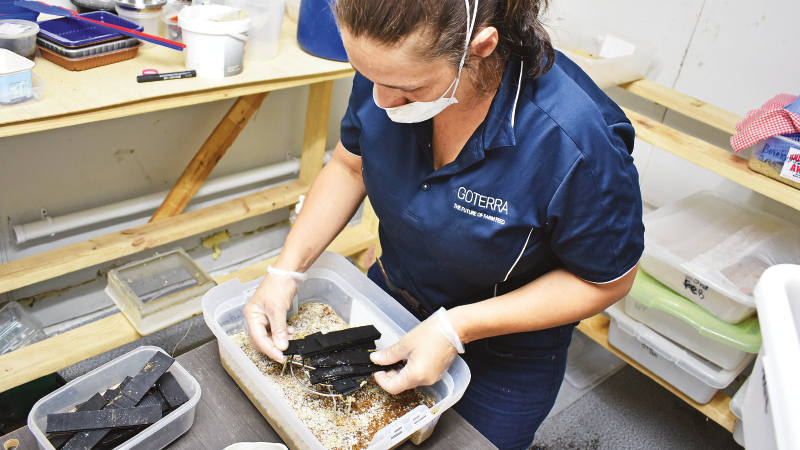 Olympia preparing egg flutes for incubation.
Olympia preparing egg flutes for incubation.
5:30am
I start the morning rounds of the warehouse, collecting eggs from the black soldier fly aviaries. The aviaries are basically large rooms where the flies mate and produce eggs. The black soldier fly is a naturalised species. Unlike blowflies, they don’t have mouths and don’t eat as adults so they don’t transmit disease. While the flies don’t eat, the larvae are voracious and an efficient composter of organic matter. One female fly can produce up to 600 larvae. The fly eggs are collected in egg flutes, which are either black coreflute [twin-wall polypropylene sheeting] or wood blocks. The flies lay their eggs in the cracks and we harvest them each day and take them to the incubator to hatch. In the incubator, we put the egg flutes on a small wire platform above a tub of wet chicken feed. When the larvae, or maggots, hatch they fall into the feed and are then collected and taken to the growing rooms.
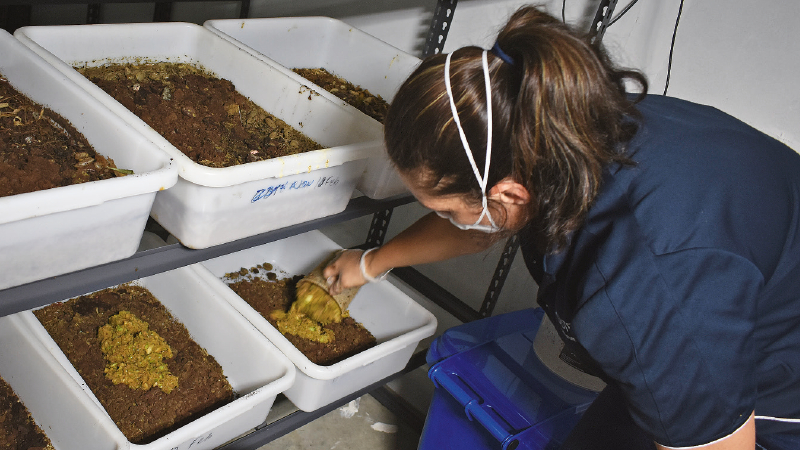 Olympia feeds food waste to larvae.
Olympia feeds food waste to larvae.
8:30am
I feed the larvae in the growing rooms which, like all the rooms in the warehouse are temperature controlled to encourage maximum productivity. The flies are sub-tropical and won’t mate or lay eggs if it’s too cold and you can kill them if it’s too hot. Similarly, the maggots can’t feed if it’s too cold and will cook if it’s too hot. We manage the temperature so we get even production all day and all year, just like a greenhouse.
The larvae are fed waste, including food waste from offices, restaurants and bakeries, coffee grounds from McDonald’s and trial agricultural waste such as grape remains from wine-making and wheat husks.
Above: Larvae feasting on cheese at Goterra.
Black soldier fly larvae are robust consumers, rapidly converting food waste into nutrients. Every tonne of larvae requires 5 tonnes of food waste for the 14-day growth cycle. This creates 200kg of larvae meal and 250kg of frass [larvae excrement]. The type of waste we feed affects the protein quality of the maggot, but we care about processing the waste first and foremost, so we manage larvae the same way any farmer manages their crop – we sell the better quality protein accordingly.
*For further insight about alternative livestock feeds and clever ways to transform waste into energy, see our story Turning pig poo into profit.
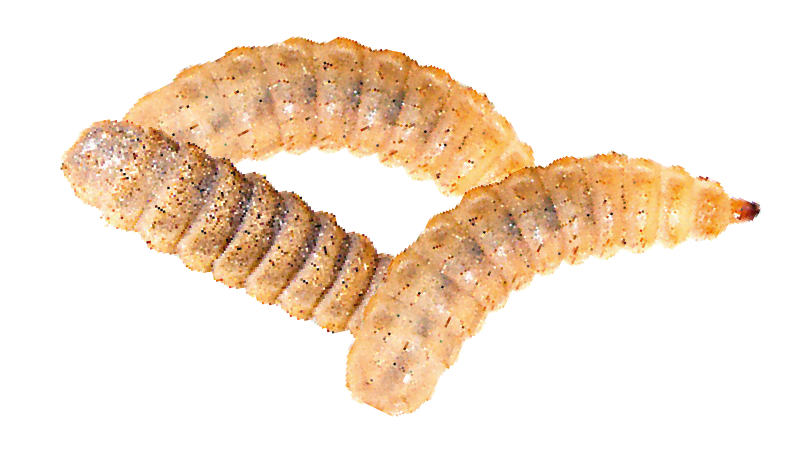 Did you know that one tonne of black soldier fly larvae consumes five tonnes of food waste in 14 days?
Did you know that one tonne of black soldier fly larvae consumes five tonnes of food waste in 14 days?
10:30am
The larvae that have been in the growing rooms for 12 days and have finished consuming the waste are taken to the processing room where they are sifted from the frass, then washed in a large sieve with water to remove the remaining waste. We then euthanise the larvae using carbon dioxide and dehydrate them to be used as livestock feed. At the moment our dehydrated larvae product is being used in pet food as well as for feed in aquaculture and pork farming. We allow other grow bins of larvae to naturally progress to the pupae stage, where they go black and emerge from the food waste after 14 days. When larvae are becoming pupae they want a dry place to begin the process of turning into a fly, and they self-harvest by crawling up out of the waste and falling through a hole in the grow bin into a green harvest bin. Each day we collect the pupae and take them to the aviary where over the next couple of days they grow legs and wings and turn into flies.
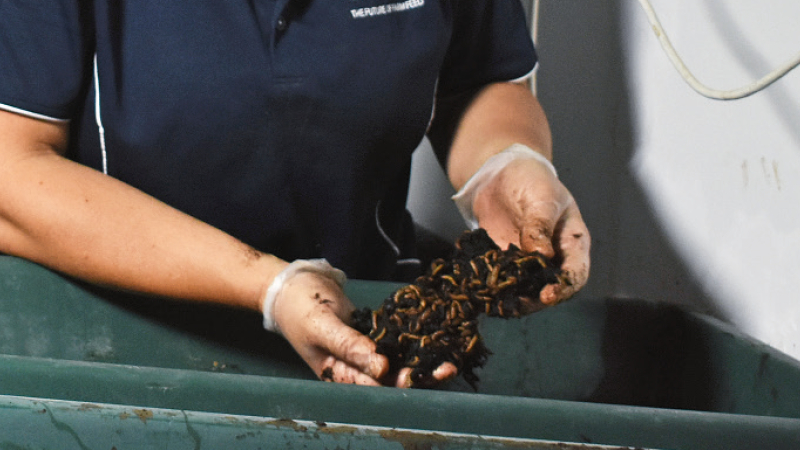 Olympia checking pupae in the harvest bins.
Olympia checking pupae in the harvest bins.
1:00pm
We also produce mealworms – darkling beetle larvae – which are farmed in trays on shelves in a big room. I check these each day to make sure everything is okay and if it is a feeding day, I give them waste. Feeding is based on average consumption, so we know how much to put in to last a certain amount of time. Mealworms don’t drink water, they get moisture from hard vegetables such as carrots, so I check they have enough and replace them if needed. Mealworms take about six weeks to complete their life cycle from egg to well-developed larvae, and I harvest larvae once a week.
The average protein value of the two main insects used in livestock feed – black soldier fly larvae and mealworms – ranges from 40-55%, which is comparable to existing chicken feed protein supplements.
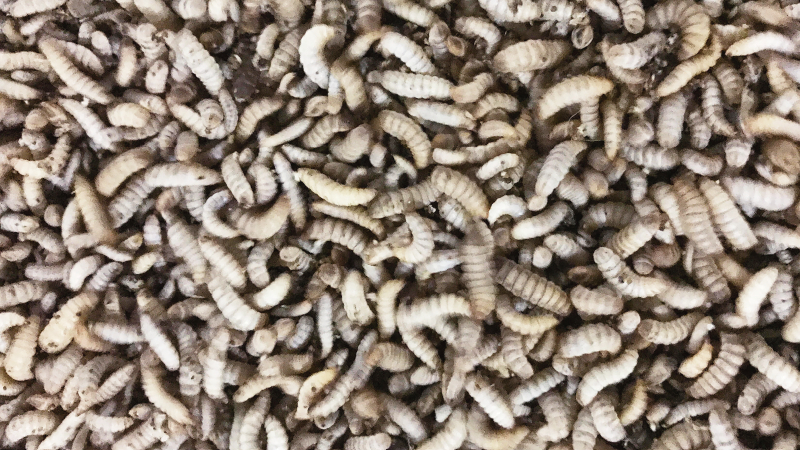 3:00pm
3:00pm
Cleaning and regulation form a large part of our process. There are currently varying and inconsistent regulations relating to insect protein for use in livestock feed and also in the use of post-consumer food waste. Goterra has developed a complete HACCP [Hazard Analysis Critical Control Point] process for farming insects. We are also an associate member of the Stock Feed Manufacturers’ Council. We spend a lot of time cleaning and washing buckets and we do this thoroughly and make sure we are organised for the next day.
5:00pm
I check the waste collection process to see where it is up to. Just like any other waste collection service, we collect some waste and have other types dropped off. How often we receive waste depends on the type. Some we get every day, others, like office waste, we get once a week. Whoever has waste, we want to manage it. We have also designed modular mobile units that can be installed onsite to collect effluent or processing waste and we will start trialling this technology this year.
7:00pm
I usually head home about now, after I have checked emails, organised any business and marketing-related work and made sure everything is finalised, ready to start again the next day.
*Interested in learning more about innovative solutions to nurture the future of agriculture? Olympia Yarger will be speaking at evokeAG held in Melbourne (Tuesday 19th - Wednesday 20th February 2019).